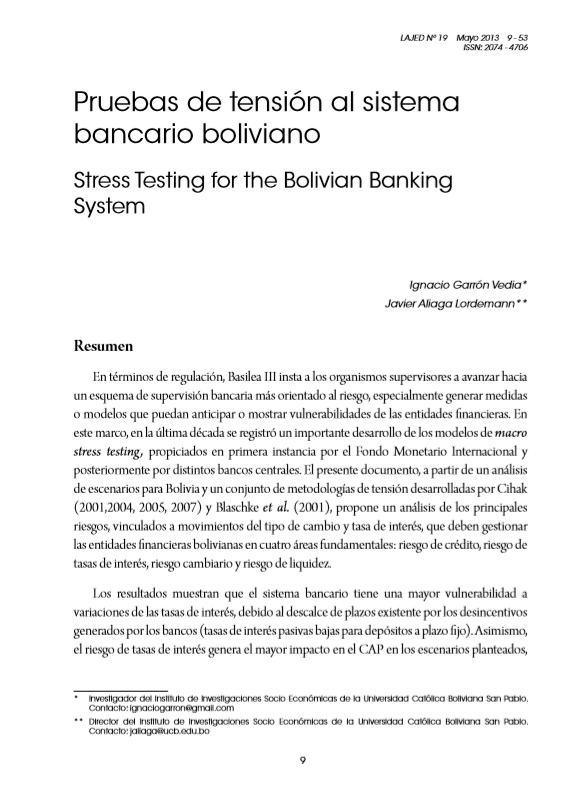Stress Testing for the Bolivian Banking System
DOI:
https://doi.org/10.35319/lajed.201319107Keywords:
Stress Tests, Financial Instability, MacroprudentialAbstract
In terms of regulation, Basel III urges supervisors to move towards a system of banking supervision more risk-oriented, especially generating measures or models that can anticipate or show vulnerabilities of financial institutions. In this attempt, throughout the last decade there was an important development of macro stress testing models, brought about primarily by the International Monetary Fund and subsequently by various central banks. This paper, based on an analysis of scenarios for Bolivia and a set of stress methodologies developed by Cihak (2001, 2004, 2005, 2007) and Blaschke, Jones, Majnoni y Martínez Peria (2001), proposes an analysis of the principal risks, linked to changes in interest rates and exchange rates, to be managed by Bolivian financial institutions for 2011 set in four key areas: credit risk, interest rate risk, foreign exchange risk and liquidity risk. The results demonstrate that the banking system is more vulnerable to changes in interest rates due to maturity gap of existing disincentives generated by the banks (low borrowing rates for fixed deposits). In addition, the interest rate risk generates the largest impact on the CAR in the scenarios presented, followed by the exchange rate risk and credit risk. Finally, the favorable results of the liquidity stress tests are explained by high levels of liquidity that the bolivian banking system receantly counts
Downloads
References
Autoridad de Supervisión del Sistema Financiero (ASFI) (ex Superintendencia de Bancos y Entidades Financieras) (2008). Guías para la gestión de riesgos. Bolivia.
---------- (2011). Anuario Estadístico. Bolivia.
---------- (2012). Recopilación de normas para Bancos y Entidades Financieras; Bolivia.
---------- Datos publicados en su página web: www.asfi.gob.bo; Bolivia.
Banco Central de Bolivia (2011). Informe de Estabilidad Financiera correspondiente al segundo semestre del 2011.
---------- (2012). Informe de Estabilidad Financiera correspondiente al segundo semestre del 2012.
---------- Datos publicados en su página web: www.bcb.gob.bo
Bank for International Settlements (2008). Principios para la realización y supervisión de pruebas de tensión.
Blaschke, Winfrid; Jones, Matthew T.; Majnoni, Giovanni y Martínez Peria, Soledad (2001). Stress Testing of Financial Systems: An Overview of Issues, Methodologies, and FSAP Experiences. International Monetary Fund (IMF), Working Paper Nº 01/88.
Borio, Claudio; Drehmann, Mathias y Tsatsaronis, Kostas (2012). Stress testing macro stress testing: does it live up to expectations? Bank for International Settelments (BIS) Working Paper N°369.
Cihak, M. (2004). Stress Testing: A Review of key Concepts. Czech National Bank Research and Policy Notes.
---------- (2007). Introduction to applied stress testing. International Monetary Fund (IMF), Working Paper, 2007.
Cihak, M. y Hermanek, J. (2005). Stress testing the Czech Banking System: Where are we? Where are we going? Czech National Bank Research and Policy Notes.
Comité de Supervisión Bancaria, Basilea II (2006). Convergencia internacional de medidas y normas de capital. Bank for International Settlements (BIS).
Delgado, Saurina (2004). Riesgo de crédito y dotaciones a insolvencias. Un análisis con variables macroeconómicas. Dirección General de Regulación, Banco de España.
Díaz, O. (2012); Identificación de booms crediticios en América Latina. Gerencia de Entidades Financieras - Banco Central de Bolivia.
Enders, Walter (2004). Applied Econometric Time Series. (2da. Edición). Estados Unidos: Wiley & Sons.
Hernández, María Fernanda; Valero, Juan José y Días, María Bernardette (2007). Perfil de riesgos del sistema bancario venezolano: aplicación de la metodología de stress testing. CEMLA.
Hoggarth, Glenn, Logan, Andrew y Zicchino, Lea (2004). Macro stress tests of UK. Banks. Bank of England.
Hull, J. (2002). Introducción a los mercados de opciones y futuros (4ta. Edición). Madrid: Prentice Hall.
Hurtado, Enrique; Villacorta, Omar y Ferruz, Luis (2008). La extranjerización del sistema bancario de Bolivia en la última década. Gestión Joven. Revista de la Agrupación Joven Iberoamericana de Contabilidad y Administración de Empresas. Nº 1.
Instituto Nacional de Estadística (INE). Datos publicados en su página web: www. ine.gob.bo.
Johansen, Soren (1988). Statistical Analysis of Cointegration Vectors. Journal of Economic Dynamics and Control, 12 (2–3), 231–254.
Jones, Matthew; Hilbers T. Paul y Slack, Graham (2004). Stress Testing the Financial Systems: What to Do When the Governor Calls. International Monetary Fund (IMF). Working Paper N°127.
Mizuho Kida, (2008). Macro stress testing model with feedback effects. Central Bank of New Zealand.
McLachlan, G. J. (2008). Mahalanobis Distance. Indian Academy of Sciences.
Sheriff, Ernesto (2010). Inflationary memory as restrictive factor of the impact of the public expense in the economic growth: lessons from high inflation Latin American countries using an innovative inflationary memory indicator. Instituto de Estudios Avanzados en Desarrollo (INESAD). Working Paper.






